
Guests
- Andre KamenshikovUkraine director for Nonviolence International and regional coordinator of the Global Partnership for the Prevention of Armed Conflict.
As a massive Russian military convoy approaches Kyiv while Russia intensifies attacks on civilian infrastructure across Ukraine, we get an update from Andre Kamenshikov, Ukraine director for Nonviolence International in the southern Kyiv suburbs. He says “people are holding out, and I think there is growing confidence that the Russian forces will not be able to take the city.” He also says Russian President Putin is using the threat of NATO as propaganda to increase domestic public support of the war, and discusses why he won’t be taking up arms as a nonviolent activist.
Transcript
AMY GOODMAN: The Russian invasion of Ukraine has entered its seventh day as Russia intensifies its attack on civilian infrastructure. The Ukrainian government is now saying over 2,000 civilians have been killed in the invasion, though that figure has not been verified. Russia is claiming it seized control of Kherson, a strategic port city on the Black Sea, but local officials are denying the claim. Another port city, Mariupol, is under heavy Russian shelling. Russian paratroopers have stormed Kharkiv, Ukraine’s second-largest city, where the mayor said shelling has killed at least 21 people and injured 112. Earlier today, a university building in Kharkiv was set ablaze after being hit by a Russian missile.
Meanwhile, the massive Russian military convoy is approaching Kyiv, Ukraine’s capital. A Russian military strike has also hit a TV tower near Kyiv. Five people were killed. The strike also damaged the Babi Yar Holocaust Memorial, which was built to commemorate the more than 33,000 Jews who were shot dead by Nazis and Nazi-led forces over a two-day period in September 1941, and the estimated 100,000 Jews, Roma and others killed near the site between 1941 and 1943. That new memorial of Babi Yar was actually funded by one of the Russian billionaires. Ukrainian President Volodymyr Zelensky was there in September for the 80th anniversary along with other leaders around the world. He said Vladimir Putin and Russia are trying to erase Ukraine.
PRESIDENT VOLODYMYR ZELENSKY: [translated] It is beyond humanity. This rocket strike proves that for many people in Russia our Kyiv is absolutely foreign. They don’t know a thing about our capital, about our history, but they all have orders to erase our history, erase our country, erase us all.
AMY GOODMAN: President Zelensky is Jewish.
The United Nations reports more than 836,000 refugees have now fled Ukraine in what’s being described as Europe’s largest refugee crisis this century.
In Washington, President Biden gave his first State of the Union address and began by focusing on the Russian invasion.
PRESIDENT JOE BIDEN: Six days ago, Russia’s Vladimir Putin sought to shake the very foundations of the free world, thinking he could make it bend to his menacing ways. But he badly miscalculated. He thought he could roll into Ukraine, and the world would roll over. Instead, he met with a wall of strength he never anticipated or imagined. He met the Ukrainian people.
AMY GOODMAN: We begin the show today in Kyiv, where we’re joined by Andre Kamenshikov, Ukraine director for Nonviolence International, regional coordinator of the Global Partnership for the Prevention of Armed Conflict.
Andre, welcome to Democracy Now! Can you talk about the situation on the ground in Ukraine’s capital, in Kyiv, right now as this convoy of tanks and military supply trucks — some estimate it’s as long as 40 miles — makes its way from Belarus, the Russian convoy, to your city?
ANDRE KAMENSHIKOV: Yes. Hello.
Well, as for the situation in Kyiv, the city of Kyiv, it’s a large city. It’s a metropolitan area with a total population of probably about 4 million people. And it’s an area that is preparing to defend itself. There is evidence that the initial plan of the Russian offensive had in mind taking over Kyiv, I think on the second or third day of the invasion. And the Russian troops reached the outskirts of the city but basically were bogged down and were stopped there, and they are still there in the near outskirts on the northwest and northeast of the city. I do not think that there is — that the Russian forces have any chance to take over a city of Kyiv, in the near future, at least. They might try to surround the city, but even that is questionable, whether they will have the capacity to do that. I think some of their greatest losses have been in the area near Kyiv so far.
JUAN GONZÁLEZ: And, Andre Kamenshikov, how are you and your loved ones staying safe? Could you talk about what the situation is, especially at night, in the city in general, in terms of levels of bombardment to the main areas of Kyiv?
ANDRE KAMENSHIKOV: It’s a big city. And I happen to be lucky, at least so far, in the sense that I live in a southern suburb of the city that has been relatively quiet. The fighting, there has been very heavy fighting and, of course, lots of destruction of property, and, I suppose, lots of civilian deaths in the areas where this fighting is taking place. That’s probably about — if you draw a straight line on Google Maps, it’s probably about 10, maybe 12, 15 miles from where I’m located. My area has been relatively safe so far. But, of course, tensions are high there. People are going along with their lives. I just came from a store. Shelves are half-empty. There are still opportunities to buy basic foodstuffs, but, for example, I wasn’t able to buy any fresh bread for the last few days. However, people are holding out, and I think there is growing confidence that the Russian forces will not be able to take the city.
JUAN GONZÁLEZ: Were you surprised —
ANDRE KAMENSHIKOV: And I think that —
JUAN GONZÁLEZ: Were you surprised by the massive extent of this invasion by Putin? Many people had expected that if he did send troops in, it would only be to the Donbas region. But now we’re looking at — I mean, after all, Ukraine is the second-largest country and territory in Europe, after Russia itself. The idea that Putin would even imagine he could occupy and subdue such a large country is really astounding.
ANDRE KAMENSHIKOV: Well, first of all, I should agree with you that when I spoke with my friends from the network that I represent, the Global Partnership for the Prevention of Armed Conflict, just maybe three or four days before the invasion began, I mentioned three most likely scenarios. The most likely scenario, that I put at maybe 50%, was that Russia will try to — as you just mentioned, will try to strengthen the separatist areas in the Donbas and maybe carry out some local offensives in the east of Ukraine around the Donbas. The second scenario would be that — that I said would probably be 50% chance, was that Putin would back off and would not invade. And I said that there would be a 20% chance that he would go in with a full invasion on all directions. I saw that as the least likely scenario, even though still, you know, I knew it could happen. And I thought that, because I was certain that — and I still am — that this kind of invasion would not bring the desired — would not reach the desired objectives of the invaders and would have a devastating effect on Russia itself and on Putin’s regime, eventually, as well.
But, unfortunately, I think that we are dealing with a leadership that is out of touch with reality, that lives in a world of its own fantasies. Putin has been in power for 23 years probably by now, and he has surrounded himself with yes men. You know, people don’t give him — basically, the people that he believes, that provide him with information, provide him with information that he wants to hear. And I believe that he sincerely believed that a significant part of the Ukrainian population, maybe even a majority or at least half of the people in Ukraine, at least the majority of people in the eastern part of Ukraine, would either welcome or tolerate his invasion. And, of course, he miscalculated very, very dramatically. But that’s what happens when you are an authoritarian leader that surrounds himself with people that only provide — whose only value is that they tell you what you want to hear anyway.
AMY GOODMAN: So, I want to ask you three quick questions, Andre. One, you’re head of the Ukraine chapter of Nonviolence International. Are you taking up arms as men and women, many, are just taking up arms in the streets, even if they’re just going to throw a Molotov cocktail? Number one. Number two, are you shocked by this number that Ukraine is putting out of 2,000 Ukrainian civilians killed? And what do you make of those who say, I mean, that Putin was responding to the eastern expansion of NATO, that Ukraine could become a part of NATO?
ANDRE KAMENSHIKOV: OK. Let’s see. The first question is: Will I take up arms? No. I am committed to nonviolence, as you can understand from the name of our nonprofit organization, Nonviolence International. And I believe that there are very many ways in which people, people of Ukraine, can nonviolently resist the current aggression. And, in fact, this is happening in many, many locations where Russian troops have invaded. You can see videos or reports of people protesting, people blocking roads, and people calling on soldiers to leave, and so forth and so on. And I believe that, basically, we see both a very strong resistance of the Ukrainian military against the invasion, but we also see a general resistance of the population. So, I see my role — I’m not a Ukrainian citizen myself, so, you know, it’s not for me to call on people to take one or another course, but I certainly see that there is also — and we see more and more — every day we see more and more forms and very interesting ways of people that find ways to nonviolently resist — ordinary people, citizens of Ukraine that find ways to nonviolently resist the Russian invasion. So, that’s the first question. The second one was — could you repeat the second?
AMY GOODMAN: The second question is: Are you surprised by the number the Ukrainian government has just put out of 2,000 Ukrainian civilians killed? They’ve also said that they’ve killed 6,000 Russian soldiers.
ANDRE KAMENSHIKOV: I’ve been — due to my work as a civil society activist working on peacebuilding and humanitarian issues, I’ve been to a number of war zones. And, in fact, what I’m seeing today in Ukraine reminds me very much of what I’ve seen many, many years ago in Chechnya. In fact, I was exactly half my current age then. But that was when I also saw Russian troops rolling into area and thinking that this would be an easy operation lasting a few days and it all turning into a bloody massacre that lasted for years.
And so, my experience is that, of course, counts of victims in wars, especially during the events, cannot be very reliable, and figures that you hear generally tend to be greatly exaggerated. But that does not mean in any way that we’re not seeing immense human suffering and large numbers of civilian casualties. There’s just no way to accurately estimate the total numbers, because Ukraine is a big country, the situation is very different in different parts of the country. Military casualties, civilian casualties, this is — you know, there is this concept of fog of war.
AMY GOODMAN: And finally, Andre, on that issue of the pretext for the invasion, that Putin was fighting against the NATO expansion?
ANDRE KAMENSHIKOV: Well, let’s say that it was actually under President Putin that Russia was seen by NATO as an ally. It was under President Putin, maybe 15, 16 years ago, that there de facto was a NATO air base, not maybe military base but a logistical base, in one of — near one of Russia’s central cities, that aided NATO operations in Afghanistan. So, if Putin is so worried about NATO expansion and sees that as such a threat, then the question is: How come, 15 years ago, he was seen as an ally, and NATO planes were allowed to be based and refueled in Russian territory? So, obviously, there’s some contradiction here.
Now, I should say that it is true that I believe that both NATO and the United States have — in the ‘90s and in the beginning of this century, have made some very serious political mistakes that, in a sense, had an effect of pushing Russia away or maybe led to the fact that the Russian leadership began seeing NATO as a potential threat to Russia. But the reality is that I think that people in Russia, and I even think that the leadership in Russia — I don’t know what’s happening in the mind of Mr. Putin. I mean, obviously, he lives in a bubble, and he doesn’t have proper information about what’s going on. But I think that the military understands that NATO is no real threat to Russia and that NATO will not attack, and that’s why they use this more as a propaganda. It might be — it might be that Putin actually believes what he says. You know, again, I don’t know. This is a question to his psychiatrist, if he has one. But today, that’s not the issue. Today, we see that — you know, we see what’s going on, and what’s going on has to be stopped. This war has to be stopped as soon as possible.
JUAN GONZÁLEZ: And, Andre, I just wanted to ask you one last question. In terms of the — obviously, all nations resist people who come into their country to try to — military occupations, and the Ukrainians are definitely showing an example to the world in the resistance. But I wanted to ask you about this decree of the Ukrainian government that men between the ages of 18 and 60 are not allowed to leave the country. Shouldn’t men, as well as women and children, who feel they want to get out be allowed to get out?
ANDRE KAMENSHIKOV: If you asked me, I would say yes. I think that Ukraine has no shortage of men who are voluntarily ready to fight for the freedom and independence of their nation. And if it would be up to me, I would not — you know, it’s a choice that people have to make. I don’t think that it makes sense to limit. You see so much — so many people willing to fight, you know, probably much more than the Ukrainian military can actually include in their ranks, that I just don’t think that would be necessary. But there are certain laws, there are certain procedures, and I guess in — you know, I’m not a specialist on Ukrainian law, and I guess they have this idea that when you have a general mobilization, you shouldn’t let people of a certain — males of a certain age group out of the country. Well, you know, you can debate whether that’s right or not. I wouldn’t do it like that, but, you know, we have to understand that the Ukrainian government is under tremendous pressure, and it works in a very difficult situation, and we see certain steps that might — you know, can be questionable.
AMY GOODMAN: Andre Kamenshikov, we want to thank you for being with us, Ukraine director for Nonviolence International, regional director of the Global Partnership for the Prevention of Armed Conflict.

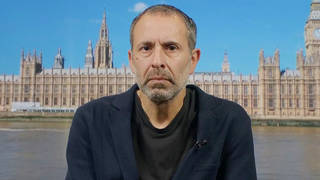
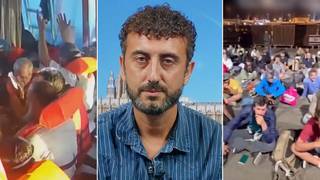
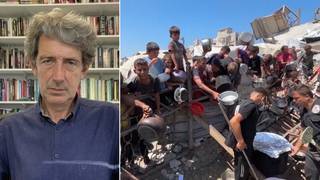
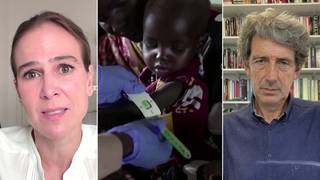



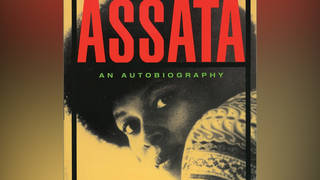

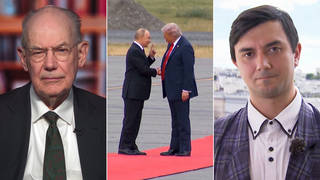
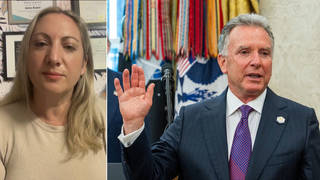
Media Options